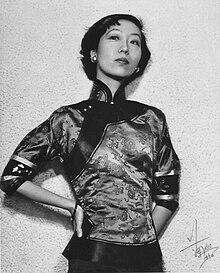User:Yile5/Eileen Chang

Eileen Chang, known as Zhang Ailing or Chang Ai-ling (1920.09.30-1995.09.01)
First husband: Hu Lancheng
Second husband: Ferdinand Reyher
Eileen Chang is good at English.
Around 1960, Chang's life was not happy and the economy was tight, so she was constantly looking for opportunities to work, such as translating and writing screenplays. [1]
In 1966, Chang had a writing residency at Miami University in Oxford. [2]
Her Works
[edit]She has many famous works, for example: <Love in a Fallen City>, <Half a Lifelong Romance>, <Little Reunions>, <Golden Cangue>, <Lust, Cauion>. These works have basically been translated into foreign languages, among them, the< Golden Cangue> was her own translation. Although she is good at English, the translation of this work is not as good as the Chinese.
Characteristics of her works
[edit]The features of Chang's works published in 1940s are that the language style will make readers feel like a "linked-chapter", but the background of the story is a modern city. And in her works there are more descriptions of the character's psychology.[3]
Her works encourages us to think about when we can help others, even in a dangerous situations.[4] Also, in her works, depictions of politics are directly affected by <War and Peace>.[5]
In Golden Cangue, Eilin Chang adopts popular language expression for her work translation, simplifying English expression and sentence structure.[6]
In 1963, in the Chang's late work, the English essay "A Return to the Frontier"; in 1975, in her last novel "Little Reunion", in these books, betrayal as act, scene, trope, or theme permeates in this essay. [7]
In Chang's late style appeared and matured when she rewritten her memories into numerous autobiography.[8]
In <Eileen Chang's Translation of The Golden Cangue>, the author analyzes in detail the language description differences between the Chinese version and the English version of the Golden Cangue.[9]
The author divides the text into two types, "source text" and "target text". The characteristics of source text are energetic, concise, and making readers pleasant to read. The characteristics of target text are no energetic, difficult for readers to understand, but the story is very attractive. Moreover, target text is more cohesive than source text.[10]
References
[edit]- ^ LEE, Christopher (2017-01-01). "Translation in distraction : on Eileen Chang's "Chinese translation: a vehicle of cultural influence"". Journal of Modern Literature in Chinese 現代中文文學學報. 14 (1). ISSN 1026-5120.
- ^ LEE, Christopher (2017-01-01). "Translation in distraction : on Eileen Chang's "Chinese translation: a vehicle of cultural influence"". Journal of Modern Literature in Chinese 現代中文文學學報. 14 (1). ISSN 1026-5120.
- ^ Qu, Lina (2020-02-09). "Writing, Rewriting, and Miswriting: Eileen Chang's Late Style Against the Grain". CLCWeb: Comparative Literature and Culture. 21 (6). doi:10.7771/1481-4374.3305. ISSN 1481-4374.
- ^ CHAN, Roy Bing (2017-01-01). "Homeless in the world : war, narrative, and historical consciousness in Eileen Chang, György Lukács, and Lev Tolstoy". Journal of Modern Literature in Chinese 現代中文文學學報. 14 (1). ISSN 1026-5120.
- ^ CHAN, Roy Bing (2017-01-01). "Homeless in the world : war, narrative, and historical consciousness in Eileen Chang, György Lukács, and Lev Tolstoy". Journal of Modern Literature in Chinese 現代中文文學學報. 14 (1). ISSN 1026-5120.
- ^ "Eileen Chang's Translation of The Golden Cangue". translationjournal.net. Retrieved 2020-10-07.
- ^ "Ends of Betrayal: Diaspora and Historical Representation in the Late Works of Zhang Ailing". MCLC Resource Center. 2014-09-23. Retrieved 2020-11-20.
- ^ Qu, Lina (2020-02-09). "Writing, Rewriting, and Miswriting: Eileen Chang's Late Style Against the Grain". CLCWeb: Comparative Literature and Culture. 21 (6). doi:10.7771/1481-4374.3305. ISSN 1481-4374.
- ^ "Eileen Chang's Translation of The Golden Cangue". translationjournal.net. Retrieved 2020-10-22.
- ^ "Eileen Chang's Translation of The Golden Cangue". translationjournal.net. Retrieved 2020-10-22.
Cite error: There are <ref> tags on this page without content in them (see the help page).
